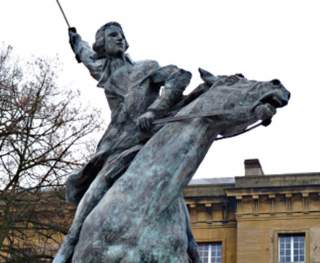How French Racehorses Are to Blame for U.S. Partisan Politics
When French revolutionaries had to literally pick sides.
It was a strange beginning for the political division that has come to dominate modern politics. The National Assembly might just as easily have retained seating by orders—clergy, nobility, and commoners in the back. It might have had the assembly hall built in the manner of the British parliament, in which the opposition parties face one another. It might even have arranged the meeting hall in a circle or oval. Any number of other options were available, any one of which would have snuffed out the new distinction between left and right.
Of course, even if left and right were never coined as such, there is little doubt that a distinction between change and continuity in politics would have gained currency in some form. As Michael Lind perceptively notes in a recent National Interest essay, if “realpolitik” had never been invented, then some synonym would have been used as a counter in debates between pragmatists and purists. This distinction is a readily available taxonomy for politics. The same can be said for left and right, for differentiating between those favoring change or continuity. Perhaps, going by the colors of the flags each side was known for during the French Revolution, those wanting change might have become the “tricolours” and those wanting continuity the “blancs.” Perhaps.
A Foreign Policy
The French Revolution was a watershed event, forever changing how government was organized in Europe. It birthed new ideas about human rights, sovereignty, representation and nationalism, ideas that would spread across the continent and beyond. It’s not too much to say that the Revolution began the modern era.
There is another achievement to add to this legacy. The year 1789 also saw the establishment of the left-right political binary. Even with the Napoleonic interlude in which these terms fell out of favor, the foundation had been set and the division returned in the Bourbon Restoration and the regimes that followed. In America, particularly after Franklin D. Roosevelt’s New Deal, “left” and “right” began to litter conversations and articles about politics. Today the terms are commonplace. After all, the whole idea of polarization in politics only makes sense within this left-right binary.
Were the Baron de Gauville to wander into the U.S. Congress now, he would recognize the two parties sitting clustered together in a manner not too dissimilar from the Manège more than two hundred years ago. Yet, he would also notice one important difference from his time. Amid America’s slavish devotion to political partisanship, his original “aim of being more the master of my opinion” would seem even more remote now. As historian Michael P. Fitzsimmons explains,
“Although there was undeniably a left and a right in the National Assembly, each with its leading figures, issues in that body were ultimately decided by a large group of men who had no personal or political ambitions, a fact avowed by both proponents and opponents of the Assembly. Most of these deputies, in fact, deliberately avoided participation in debate and preferred anonymity. Their modesty and reticence have, for the most part, led historians to overlook them, but they were the driving force of the National Assembly. They wanted to do what was best for France and cared not at all from which side of the Assembly proposals originated; indeed, they were not ideologues and took great pride in their lack of esprit de parti.”
A pragmatic, anti-partisan faction held the center of the nation’s main political body. This faction was held together only in sharing the idea that each member judge for himself what is best for the nation. And it worked, for awhile. As one French deputy cited by Fitzsimmons explained in November 1789, “the truth is that the Assembly as a whole brings together a mass of considerable knowledge that, despite the most tumultuous debates, almost always makes its way straight to the goal.” These notions of political anti-partisanship and legislative effectiveness, even more than the left and the right’s French origin, must surely strike many Americans today as entirely foreign.
John Richard Cookson is a writer in Washington, DC.
Image: Statue of the Marquis de Lafayette in Metz, France. Wikipedia/@Bava Alcide57

